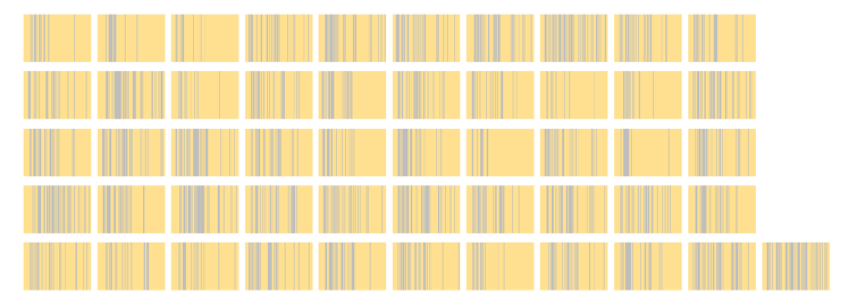5 Things JobsEQ Has That Government Sources Don’t Have

Don’t get us wrong. We love government data, with shout-outs to the Bureau of Labor Statistics (BLS), the U.S. Census Bureau, and the Bureau of Economic Analysis (BEA). Those sources produce superlative data sets that are the foundation of much of our data and analysis in JobsEQ by Chmura. If you already get labor data from these sources, that’s a great first step.
But JobsEQ includes a lot of labor market data and analysis that government sources don’t have or have to suppress. JobsEQ doesn’t just repackage publicly available data — our economists add crucial data and analysis to JobsEQ to improve the quality of your research and help you win.
Here are five things that JobsEQ has that government sources don’t have:
1. Information on non-disclosed (ND) data
Your benefit: JobsEQ provides you more complete employment numbers than the BLS by filling in the blanks.
You go to the BLS’s Quarterly Census of Employment and Wages (QCEW) and look up employment in an industry for one of your largest employers. Instead of a number, you find (ND), or maybe the industry isn’t shown at all. What does that mean, and why aren’t some data available?
“ND” (or “n.d.” or similar variations) in data from the Bureau of Labor Statistics (BLS) indicates that those data are Not Disclosable. The data have been collected; however, they have been suppressed in public releases.
Generally, BLS decides whether to disclose data when one of the following is true:
- There are fewer than three establishments in an industry for a certain geography, or
- One employer accounts for more than 80% of all employment in an industry in the area.[1]
This is a really big deal. These types of suppressions happen at every geographic level, and missing those details leaves you with an incomplete picture of your economy.
JobsEQ by Chmura fills in these gaps in the data. We make our estimates by combining many other data sources for reliable information, with modeling backed by our team of economists, statisticians, and data scientists to ensure accuracy and reliability at all levels of detail.

Each square in the above graphic represents QCEW data for a state, with blue lines showing suppressed lines of data.
2. Preliminary Estimates that bring data forward
Your benefit: More timely and accurate data. JobsEQ is six months ahead of the QCEW from BLS.
You need timely data on employment. BLS’s Quarterly Census of Employment and Wages (QCEW) is the most accurate and comprehensive primary source for industry employment data in the United States—but there’s a problem. The QCEW is usually two quarters (six months!) behind real time. In an era of COVID-19, you need more up-to-date information than that.
JobsEQ uses Preliminary Estimates to bring the data forward one-to-two quarters, so your data is more timely than QCEW. How? We use the Current Employment Statistics (CES), county-level industry trends, and careful modeling to create highly accurate estimates.
In a recent performance check, we found that using Preliminary Estimates makes your county-level employment data 58% more accurate than if you had used the most recent QCEW available (which would be six months behind). You can read more about our methodology here.
3. A COVID-19 forecast
Your benefit: Understand how COVID-19 will impact jobs and industries in the future.
Are you wondering how COVID-19 will affect what jobs will be in-demand over the next few years?
JobsEQ’s Alternative COVID Forecast can help. We’ve used our 30+ years of experience as PhD economists, Blue-Chip forecasters, and data scientists to forecast the near-term impact of COVID quarter-by-quarter, based on current expectations of when a vaccine may be available.
You can use this forecast to see how occupations and industries will be affected by COVID-19. Now, you’ll feel confident that your plans are based on the most up-to-date and expert information available.
Neither the BLS nor any other labor market software tool has a COVID-19 forecast, let alone one that is fully integrated with regional industry and occupation job forecasts—which means JobsEQ clients have a competitive advantage. Read about our methodology and assumptions here.
4. Accurate economic impact model
Your benefit: Accurately measure the economic impact of a firm relocating to your region.
Do you need to evaluate the economic impact of a potential project, like a business expansion or relocation? Government officials want an accurate estimate on the value a new firm brings. With JobsEQ’s economic impact model, you can feel confident that your economic impact is accurate. Conversations about potential incentives will now be based on reliable data, not someone’s best guess.
Often, economic impact models overestimate actual benefits. Ours doesn’t. Our PhD economists developed JobsEQ’s economic impact model so that it’s highly customized to your region. The model will show the direct, indirect, and induced impact of a potential business expansion. In fact, we used the JobsEQ economic impact model when we measured the national economic impact of the interior design industry.
You can read our detailed economic impact methodology here.
5. Real-time job postings data
Your benefit: Use real-time job postings data to keep up with daily economic trends. Cross-reference job postings with structured data from the BLS.
In an era of COVID-19, it seems like the economy changes drastically every week. JobsEQ contains job postings data that updates daily, so you can stay on top of economic trends in your region. We call it “Real-Time Intelligence” (RTI). Government sources do not have such a data set.
Our RTI job postings gives real-time updates on the number of job openings by occupation, location, employer, job titles, certifications, skills, and compensation. You can also track how the number of job postings has changed over time, to compare your current number of job postings to the past.
“RTI’s numbers are specific enough that I have trends to talk about. It’s a snapshot of what’s happening in a dynamic labor market,” says Jesse McCree, CEO of SCPa Works and JobsEQ client since 2017.
Read more about our Real-Time Intelligence data here.

Why it matters for your research
We love government data, but we also have a lot of data and analysis you won’t find there. JobsEQ doesn’t just repackage publicly available data. We add data and analysis that improves your quality of research. That means you make better decisions and help more people.
Let’s hear again from Jesse McCree:
“I could not understand how we didn’t have any labor market software. I was cobbling the data together from different sources and spending a lot of time and energy to get few results. When I became the CEO, I told my team ‘We're going to pay money to get labor market intelligence the right way and the professional way.’”
That’s why Jesse chose JobsEQ. Get a demo today to see how Chmura's tech can help your organization achieve informed success.
Subscribe to the Weekly Economic Update
Subscribe to the Weekly Economic Update and get news delivered straight to your inbox.











